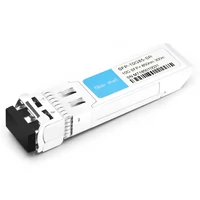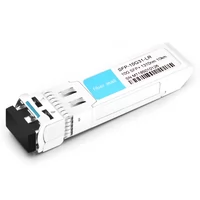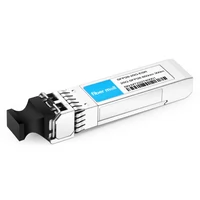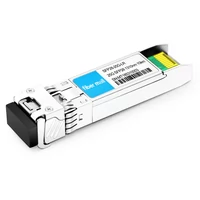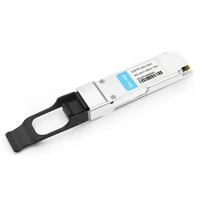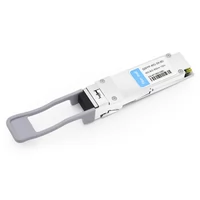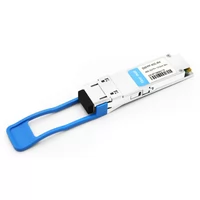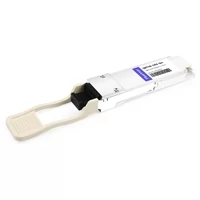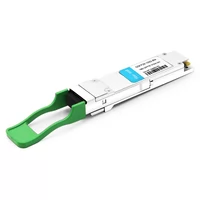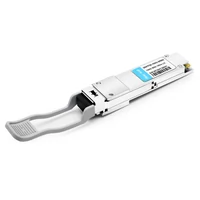Cisco’s three-tier network architecture model is widely used in network design to bring users a secure, reliable, scalable, and cost-effective interconnect network. The aggregation layer in the three-layer network architecture model plays the role of uploading and distributing. As the physical entity of the aggregation layer, the aggregation switch’s primary function is to aggregate the data of the access layer switch and forward it to the core switch to reduce the burden on the core layer.
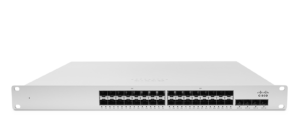
Cisco’s aggregation switch
Table of Contents
ToggleWhat is the Role of the Aggregation Switch in the Network?
The aggregation switch is located in the middle of the network architecture, which is equivalent to a middle-level manager of a company. It needs to be responsible for managing the data from the lower layer (the access layer switch), and at the same time, it also reports data to the upper layer (the core layer switch).
Usually, when the aggregation switch receives data from the access switch, it will perform local routing, filtering, traffic balancing, and QoS priority management. Then it will process the security mechanism, IP address translation, and multicast management of the data. Finally, it will forward the data to the core layer switch or perform local routing processing according to the processing result to ensure the normal operation of the core layer.
It can be seen from the above that the aggregation switch has functions such as source address, destination address filtering, real-time policy, security, network isolation, and segmentation. Compared with access switches, aggregation switches have better performance and higher switching speeds.
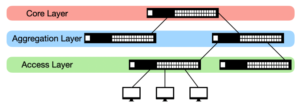
The aggregation switch is located in the middle of the network architecture
However, in practical applications, some network architectures only have access switches and core switches without aggregation switches. The reason is that the network is small, simple, and has a short transmission distance. Users do not deploy aggregation switches to reduce network costs and maintenance burden. However, if the number of network users exceeds 200, and the number of users will continue to grow in the future, it is recommended to deploy aggregation switches.
What Factors Should be Considered When Choosing an Aggregation Switch?
Since the vast majority of networks will deploy aggregation switches, what factors should be considered when selecting aggregation switches? We can start from the following aspects:
-
Backplane Bandwidth and Packet Forwarding Rate
As we all know, backplane bandwidth and packet forwarding rate are important factors to measure the ability of a switch to forward packets. The smaller the backplane bandwidth and packet forwarding rate, the weaker the data processing capability of the switch. If the line speed cannot be reached, it will easily cause congestion. At present, most switches on the market can achieve wire-speed switching. Therefore, when selecting an aggregation switch, we can choose the appropriate one according to actual needs to avoid resource wastage.
-
Port Type and Number of Ports
The convergence switch converges data of a plurality of access switches and then forwards them to the core switch. Therefore, it is necessary to take into account the type and number of uplink ports in the network access switch, and the downlink port type of core switch when selecting the convergence switch. For example, when the convergence switch needs to be connected to the access switch with the SFP optical port, a convergence switch with the SFP optical port at the downstream port is selected. The specific number of ports is determined by the number of access switches to be connected, such as 24 port and 48 port convergence switches.
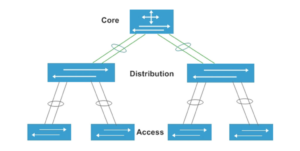
The distribution function of the aggregation switch
In addition, with the continuous development of network communication technology, the network scale will become larger and larger. So, it is better to consider the scalability of switch ports when selecting convergence switches and try to choose an enterprise switch with scalable ports.
-
Port Rate
The choice of converging switch port rate also takes into account the upstream and downstream links. The port rate can be the same or different, such as both uplink and downlink are gigabytes, or downlink is gigabytes, and uplink is ten megabytes. The specific choices depend on the uplink port rate of the access switch and the downlink port rate of the core switch.
-
Function management
Unlike the core switch, the aggregation switch can choose either the layer 2 switch or the layer 3 switch. When the layer 2 switches are selected, the routing and management strategy must be completed by the core switch. However, some commonly used network management functions are necessary, such as link aggregation, QoS, VLAN, ACL, etc.
-Link aggregation
The convergence switch needs to receive traffic from multiple access switches and forward all traffic to the core switch as quickly as possible (that is, the convergence switch needs a high-bandwidth aggregation link connected to the core switch). Therefore, the convergence switch needs to support the link aggregation function to ensure that sufficient bandwidth is provided for the access layer and that it still works when one of the links is disconnected.
-QoS
At present, most users will access video, voice, and other equipment in the access layer, which leads to a rich variety of traffic types in the LAN. The QoS priority strategy can prioritize the transmission of specified traffic (such as voice and video) to ensure its quality of service. Therefore, it is necessary to select enterprise-level switches that support QoS as aggregation switches when purchasing, otherwise, the performance and quality of voice and video communications will not be guaranteed during network transmission.
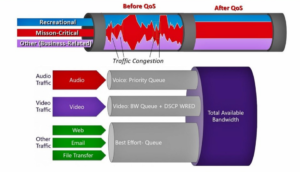
QoS guarantees the performance of traffic
-Security policy
To prevent illegal intrusion, interception, and access to the network by bad information or other network devices, the aggregation switch can select enterprise-level switches that support security policies, such as ACL (access control list). These switches can identify the allowable traffic types, effectively prevent some types of traffic from being transmitted, and ensure cyber security.
-
Redundancy
The capability of redundancy is the guarantee of the cyber security operation, and it is also one of the significant factors when selecting a convergence switch. For a convergence switch, power redundancy is very crucial. Because when one of its power supplies fails or needs to be replaced, the switch can rely on another power source to continue to work without affecting the normal operation of the network.
We use the following switch, which is commonly used in data centers, to illustrate its configuration and features.
24-port 10GbE Layer 3 aggregation network switch (including four 25G optical ports, backward compatible with 10G), 2 x 40G uplink ports
It can be used for the network core and network aggregation of SMEs.
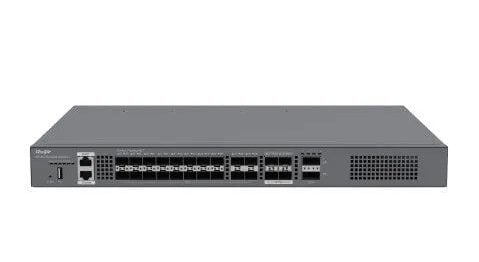
24-port 10GbE Layer 3 aggregation network switch
Product Features:
- Abundant port types, twenty10G optical ports, four 10G/25G optical ports, and two 40G optical ports for uplink.
- Support VSU virtualization technology, and has strong flexible networking performance.
- Hardware-level multiple protection, support hot-plug redundant power supplies, intelligent dual fans, and dual-boot redundant backup.
- Real-time network security monitoring, and support the CPP and NFPP, to guarantee the sustainable robustness of the network.
- SoundQos strategy, flexible allocation of network resources, stable rate, and no congestion.
- Support SNMP, RMON, Syslog, USB features, and multiple management such as CLI, Web network management, and Telnet, easy to maintain.
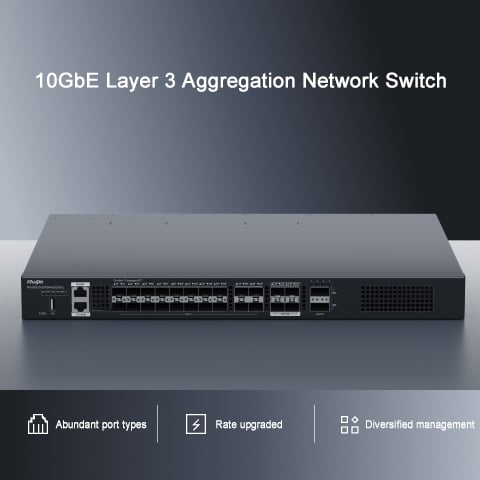
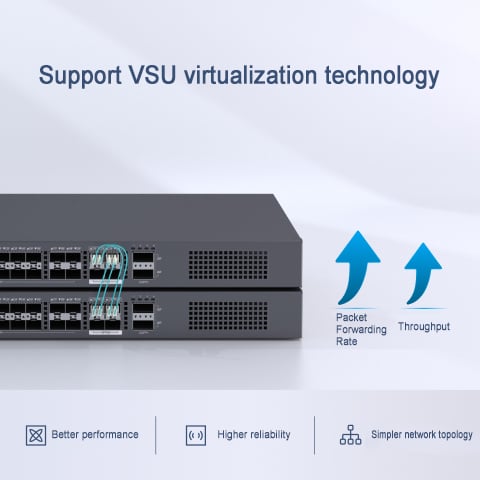
|
Basic Specifications |
|||
| Fixed ports | 20 10G/1G SFP+ interfaces,
4 10G/25G SFP28 optical ports, 2 40G QSFP+ optical ports |
Power supply redundancy backup | 1+1 |
| Management ports | 1 10/100/1000Base-T adaptive Ethernet interface
1 USB 2.0 interface 1 RJ45 Console interface |
Maximum power consumption of the whole machine | 70W |
| Packet Forwarding Rate | ≥570Mpps | Host size (W×D×H) | 440mm×330mm×43.6mm |
| Switching Capacity | 2.56T/25.6T | Rated input voltage range | 100V AC~240V AC, 50~60Hz 192V DC~288V DC |
| VSU Technology | Support | Temperature | Operating temperature: 0°C~50°C
Storage temperature: -40°C~70°C |
| Link Aggregation | Support | Fan Monitoring | Fault alarm: Support
Intelligent speed control: Support |
| Power hot-pluggable | Support | Warranty | 3 years |
| Fan hot-pluggable | Support | ||
10GbE Layer 3 All-Optical Aggregation Network Switch
It can be used as a network aggregation device in small and medium-sized parks, providing gigabit to 40G optical ports. It has powerful forwarding performance and data processing capability and supports large-capacity switching services.
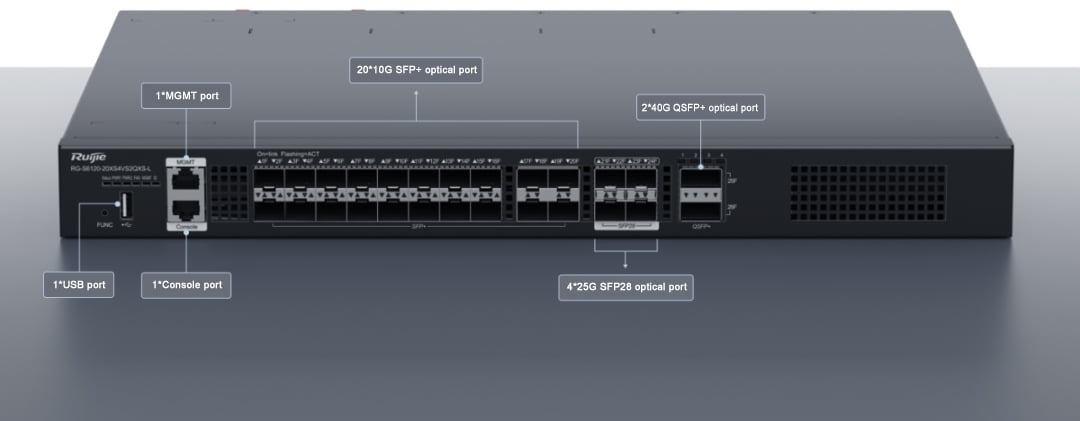
Can be used for small and medium-sized enterprise core equipment, the whole machine provides high reliability, efficiency, redundancy, and manageability, and can improve network performance.
Support VSU Virtualization Technology, Flexible Networking Performance
Millisecond fault recovery, highly scalable, simplifies networking.
If the aggregation link between the VSU and peripheral devices fails, the link can be switched over at the millisecond level to ensure network continuity.

Multiple hardware-level protection ensures continuous device operation and stable network connection
Hardware-level dual boot 1+1 intelligent fans hot-pluggable redundant power supplies.
Two FLASH chips are used to store boot software (system boot program) to realize hardware-level boot redundancy backup.
Avoid the failure of the FLASH chip to cause the switch to fail to boot.

Multiple Network Security Policies, Real-time Monitoring, Continuous Network Robustness
CPP protection strategy and NFPP protection strategy
Protect CPU from data attacks, ensure CPU stability under high operation, and effectively improve the security performance of the device.

Sound QoS Policy to Achieve Flexible Allocation of Network Resources
Stable rate without congestion.
With MAC flow, IP flow, application flow, etc.
Multi-layer flow classification and flow control capability.
Ensure accurate allocation of multi-service traffic to achieve network usage without congestion and provide a high-quality network.
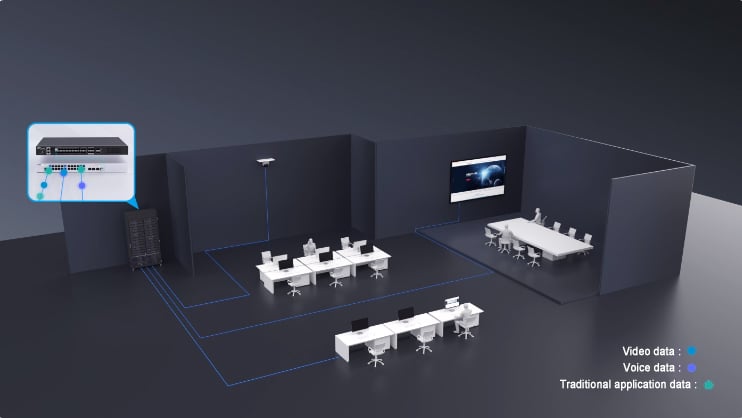
Multiple Network Management Enables Simple and Easy Network Maintenance
Management features, management mode, multi-device management.
Support RMON, Syslog, and USB backup log feature to ensure normal diagnosis and maintenance of daily network use.
FAQs
Question 1: Is the 10GbE optical port of the switch backward compatible?
The 10G optical port of the switch is compatible with gigabit optical modules and can be backward compatible with gigabit.
Question 2: What is the uplink port of the 10GbE Layer 3 all-optical aggregation network switch?
The uplink port is 40G, which can connect core layer devices upward, and the whole machine belongs to an all-optical 10 Gigabit switch. This switch supports and realizes the number of 10G/1G interfaces ≥ 20, the number of 25G/10G interfaces ≥ 4, and the number of 40G interfaces ≥ 2 to achieve port upgrade and rate upgrade.
Question 3: Does this switch need a separate power supply?
The switch has 2 modular power supply slots, which require at least one additional power supply. The power supply model is RG-PA150I-F, which can also be equipped with dual power supplies for redundancy.
Question 4: What is the power supply voltage of this aggregation witch?
The maximum AC input voltage range is 90-264VAC, the frequency is 47/63Hz, and the rated input current is 3A. The maximum voltage range for the HV input is 192-288VDC. The rated current of each input is 3A and a 150W AC power module is supported.
Question 5: How to solve this aggregation switch port failure?
The device supports fault isolation technology to monitor the status of the optical module. Once a fault occurs, it can immediately identify and isolate the faulty module to ensure that it does not affect other ports and the normal operation of the entire system. After replacing the module, the port can immediately return to normal operation.
Question 6: What are the management methods of Layer 3 10GbE all-optical port aggregation switch?
Administrators can use command line interface (CLI), Web network management, Telnet, and other methods, and support SNMP, RMON, Syslog, USB backup log, and configuration features for daily diagnosis and maintenance of the network to achieve diverse management and maintenance methods and more convenient management of the device.
The device also supports hardware health status visualization, which can monitor fan status, power supply, temperature, and onboard voltage, especially when abnormal voltage precursors are found during daily inspections, which can be handled in time to avoid abnormal voltage downtime.
Recommend Reading:
Understanding Access Switches: Key Components of Your Network Switch Setup
Related Products:
-
 SFP-10G85-SR 10G SFP+ SR 850nm 300m LC MMF DDM Transceiver Module
$12.00
SFP-10G85-SR 10G SFP+ SR 850nm 300m LC MMF DDM Transceiver Module
$12.00
-
 SFP-10G31-LR 10G SFP+ LR 1310nm 10km LC SMF DDM Transceiver Module
$18.00
SFP-10G31-LR 10G SFP+ LR 1310nm 10km LC SMF DDM Transceiver Module
$18.00
-
 Cisco SFP-10/25G-CSR-S Compatible 25G SFP28 ESR 850nm OM3 200m/OM4 300m LC MMF DDM Transceiver Module
$35.00
Cisco SFP-10/25G-CSR-S Compatible 25G SFP28 ESR 850nm OM3 200m/OM4 300m LC MMF DDM Transceiver Module
$35.00
-
 Cisco SFP-10/25G-LR-S Compatible 25G SFP28 LR 1310nm 10km LC SMF DDM Transceiver Module
$45.00
Cisco SFP-10/25G-LR-S Compatible 25G SFP28 LR 1310nm 10km LC SMF DDM Transceiver Module
$45.00
-
 QSFPP-40G-SR4 40G QSFP+ SR4 850nm 150m MTP/MPO MMF DDM Transceiver Module
$25.00
QSFPP-40G-SR4 40G QSFP+ SR4 850nm 150m MTP/MPO MMF DDM Transceiver Module
$25.00
-
 Cisco QSFP-40G-SR-BD Compatible 40G QSFP+ SR Bi-Directional 850nm/900nm 100m/150m Duplex LC MMF Transceiver Module
$249.00
Cisco QSFP-40G-SR-BD Compatible 40G QSFP+ SR Bi-Directional 850nm/900nm 100m/150m Duplex LC MMF Transceiver Module
$249.00
-
 Cisco WSP-Q40GLR4L Compatible 40G QSFP+ LR4L 1310nm (CWDM4) 2km LC SMF DDM Transceiver Module
$129.00
Cisco WSP-Q40GLR4L Compatible 40G QSFP+ LR4L 1310nm (CWDM4) 2km LC SMF DDM Transceiver Module
$129.00
-
 Cisco QSFP-100G-SR4-S Compatible 100G QSFP28 SR4 850nm 100m MTP/MPO MMF DDM Transceiver Module
$40.00
Cisco QSFP-100G-SR4-S Compatible 100G QSFP28 SR4 850nm 100m MTP/MPO MMF DDM Transceiver Module
$40.00
-
 Cisco QSFP-100G-CWDM4-S Compatible 100G QSFP28 CWDM4 1310nm 2km LC SMF DDM Transceiver Module
$110.00
Cisco QSFP-100G-CWDM4-S Compatible 100G QSFP28 CWDM4 1310nm 2km LC SMF DDM Transceiver Module
$110.00
-
 Cisco QSFP-40/100-SRBD Compatible Dual Rate 40G/100G QSFP28 BIDI 850nm & 900nm 100m LC MMF DDM Optical Transceiver
$449.00
Cisco QSFP-40/100-SRBD Compatible Dual Rate 40G/100G QSFP28 BIDI 850nm & 900nm 100m LC MMF DDM Optical Transceiver
$449.00

